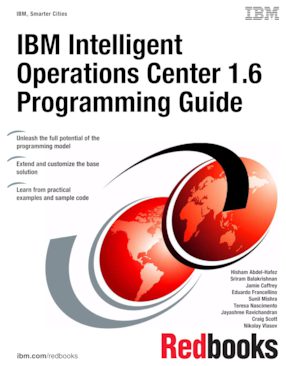
Published on 28 May 2014
Read in Google Books Order hardcopy
Share this page:
ISBN-10: 0738439339
ISBN-13: 9780738439334
IBM Form #: SG24-8201-00
Authors: Hisham Abdel-Hafez, Sriram Balakrishnan, Jamie Caffrey, Eduardo Francellino, Sunil Mishra, Teresa Nascimento, Jayashree Ravichandran, Craig Scott and Nikolay Vlasov
Abstract
IBM® Intelligent Operations Center is an integrated solution. It provides a rich set of capabilities and line of business tools that business users with domain expertise and no technical background can use without customization.
IBM Intelligent Operations Center also provides services and extension points that developers can use to extend the IBM Intelligent Operations Center standard functions and develop capabilities specific to the domain and client requirements.
IBM Intelligent Operations Center includes an application-based programming model that supports all the interactions with the solution components. The programming model is based on industry standard Representational State Transfer (REST) and Java technologies. IBM Intelligent Operations Center includes a full set of REST and Java application programming interfaces (APIs) that provide a simplified development environment and make the platform easy to extend and customize for a large community of developers.
This IBM Redbooks® publication gives a broad understanding of the IBM Intelligent Operations Center 1.6.0.1 programming model and available extension points. Many of the chapters describe working examples and usage scenarios that demonstrate how to extend the IBM Intelligent Operations Center base platform. This book includes sample code that can be downloaded from the IBM Redbooks website.
The target audience for this book consists of solution architects, developers, technical consultants, and solution administrators who will learn the following information:
- The options available to extend the IBM Intelligent Operations Center solution programmatically
- How to configure customizations tailored to specific customer requirements
- How to use the available configuration tools to configure the solution without requiring programming
Readers of this book will benefit from the IBM Redbooks publication IBM® Intelligent Operations Center 1.5 to 1.6 Migration Guide , SG24-8202.
Table of Contents
Chapter 1. IBM Intelligent Operations Center programming model overview
Chapter 2. Sample scenario
Chapter 3. Integrating with data sources
Chapter 4. Tracking key performance indicators
Chapter 5. Driving standard operating procedures
Chapter 6. Customizing the operations display
Chapter 7. Visualizing information with maps
Chapter 8. Developing mobile applications
Chapter 9. Integrating with external systems
Chapter 10. Creating and viewing reports
Appendix A. Development tools
Appendix B. Samples provided with this book
Appendix C. Additional material
Related publications